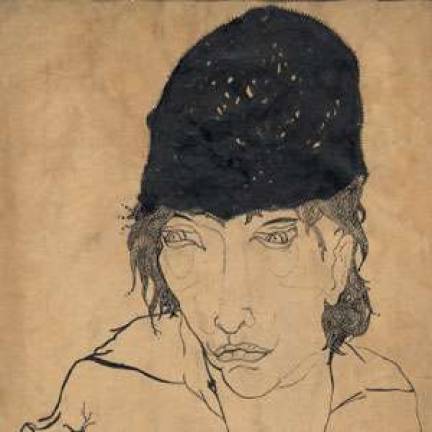City Arts: Turning Journalism Into Art

We may have been reading the wrong thing all along. Blame it on T.S. Eliot, who proclaimed Djuna Barnes' stylistically avant-garde Nightwood equal to great Elizabethan tragedy-the novel was canonized by many in lesbian literature as a breakthrough: a lightly disguised version of Barnes' breakup with her female lover.
You can't argue with those folks. Yet the real action may be in Barnes' work-for-hire as a self-styled journalist/illustrator, now on view in Newspaper Fiction: The New York Journalism of Djuna Barnes, 1913?1919 at the Brooklyn Museum. With a unique combination of selfinsertion, the telling detail, painting and drawing, she worked from 1913 though 1919 at The Brooklyn Eagle, The World, The Telegraph- an ur-Tom Wolfe, a New Journalist. She called her form "Newspaper Fiction."
Barnes' writing style is smashing, her sideways take on her subjects disarming. In "Visiting a Gorilla (at the Bronx Zoo)," Barnes observes that the gorilla has a "queer sort of drawingroom caution?a cold sort of appraising stare that holds neither envy nor malice."
To demonstrate the complacency of American suffragettes vis-à-vis their hunger-striking British counterparts, she lets herself be force-fed by a rubber tube, describing each excruciating "drip drip" (step aside, George Plimpton, with your participatory sports journalism). She does stunt journalism-"My Adventures Being Rescued" at a firefighters' training session-and socially progressive pieces on the plight of orphans, pointing out that the blue-eyed ones get adopted first. On occasion she creates or embellishes characters.
Flâneur strolls through Greenwich Village produce memorable vignettes and images of bohemian life: The day begins with breakfast at 4 p.m.; purple ties and yellow bathrobes can be the norm. Another series profiles elderly gentlemen happy to be still working after 40-plus years as train conductors or waiters, providing a grounds-up view of old New York.
The original articles-slightly tattered, sepia-toned, some with photos of Barnes- are safely behind glass on the wall. (Can't get tippy-toe high or close enough? Find them in a book cleverly tethered to a nearby bench.) If you imagined Barnes in a continental café sipping a thick coffee, fretting about the human condition (or caught her "cameo" in Woody Allen's Midnight in Paris), views of this sprightly young dame are a breath of fresh air. She did get to Europe on a Vanity Fair assignment in 1922 to interview James Joyce, and stayed until the eve of World War II.
Surely Barnes, who died at 90 in 1982, would be happy that Judy Chicago's "Dinner Party," which includes her, is in the next room, and that her exhibit faces the vulvar images in the Herstory Gallery's feminist timeline mural.
Newspaper Fiction: The New York Journalism of Djuna Barnes, 1913?1919 Through Aug. 19, Brooklyn Museum, 200 Eastern Pkwy., Brooklyn, 718-638-5000,www.brooklynmuseum.com.
To find out more about exciting events in New York, pick up the latest issue of City Arts, or click here.